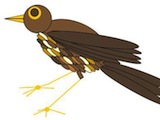Émilie Arnoux PhD thesis
 Phenotypic and genetic variability in forest thrush, Turdus lherminieri, at different scales
Phenotypic and genetic variability in forest thrush, Turdus lherminieri, at different scales
Defended on the 6th December 2012
Funding: région Bourgogne, Office national de la chasse et de la faune sauvage
Supervisor: Bruno Faivre; co-supervisors: Stéphane Garnier and Cyril Eraud
Started in November 2009
Abstract
Understanding the mechanisms underlying population structure is a crucial issue in evolutionary biology and ecology. Identifying the processes driving biodiversity is also of prime interest to draw up guidelines for population management and conservation planning. Level of differentiation depends on a subtle balance between gene flow, genetic drift and natural selection and insight into the relative contribution of these factors can be provided by spatial and temporal patterns of intra-specific phenotypic and genetic variations. Differentiation has mainly been studied in insular systems because i) islands give ideal framework to study divergence in species ii) islands enclosed endemic fauna and flora. These endemic species are characterised by small population sizes and small distribution areas. They are consequently more fragilized by strong environmental changes. The Forest thrush Turdus lherminieri is an endemic and understorey bird present in four islands of Lesser Antilles: Montserrat, Guadeloupe, Dominica and Saint-Lucia. Four subspecies have been described on each island on the basis of feathers coloration but no study has really quantified the divergence between these subspecies. In addition, bird numbers have decline since 15 years and now Forest thrushes are protected on three islands but are always hunted in Guadeloupe. Aims proposed in this study are i) to study the spatial structure in Forest thrush in order to deduce potential causes of this structure ii) to describe the temporal evolution of genetic diversity, iii) to determine if parasites can exert contrasted selection pressures which follow gentic and morphological pattern in Forest thrushes populations. In this study, we have identified three clades and subspecies on each island which are differentiated morphologically and genetically. At fine scale i.e Guadeloupe only, we have revealed an uncommon level of differentiation. In last, the parasites’ structure seems to follow the morphological and genetic structure observed in Forest thrushes. To conclude, three management units can be defined: a first in Saint-Lucia, a second in Dominica and a third including Montserrat and Guadeloupe.
Keywords
speciation, insularity, endemism, forest thrush, conservation
- extrait:
- lien_externe:
- kc_data:
- a:8:{i:0;s:0:"";s:4:"mode";s:0:"";s:3:"css";s:0:"";s:9:"max_width";s:0:"";s:7:"classes";s:0:"";s:9:"thumbnail";s:0:"";s:9:"collapsed";s:0:"";s:9:"optimized";s:0:"";}
- kc_raw_content:
 Phenotypic and genetic variability in forest thrush, Turdus lherminieri, at different scales
Phenotypic and genetic variability in forest thrush, Turdus lherminieri, at different scalesDefended on the 6th December 2012
Funding: région Bourgogne, Office national de la chasse et de la faune sauvage
Supervisor: Bruno Faivre; co-supervisors: Stéphane Garnier and Cyril Eraud
Started in November 2009
Abstract
Understanding the mechanisms underlying population structure is a crucial issue in evolutionary biology and ecology. Identifying the processes driving biodiversity is also of prime interest to draw up guidelines for population management and conservation planning. Level of differentiation depends on a subtle balance between gene flow, genetic drift and natural selection and insight into the relative contribution of these factors can be provided by spatial and temporal patterns of intra-specific phenotypic and genetic variations. Differentiation has mainly been studied in insular systems because i) islands give ideal framework to study divergence in species ii) islands enclosed endemic fauna and flora. These endemic species are characterised by small population sizes and small distribution areas. They are consequently more fragilized by strong environmental changes. The Forest thrush Turdus lherminieri is an endemic and understorey bird present in four islands of Lesser Antilles: Montserrat, Guadeloupe, Dominica and Saint-Lucia. Four subspecies have been described on each island on the basis of feathers coloration but no study has really quantified the divergence between these subspecies. In addition, bird numbers have decline since 15 years and now Forest thrushes are protected on three islands but are always hunted in Guadeloupe. Aims proposed in this study are i) to study the spatial structure in Forest thrush in order to deduce potential causes of this structure ii) to describe the temporal evolution of genetic diversity, iii) to determine if parasites can exert contrasted selection pressures which follow gentic and morphological pattern in Forest thrushes populations. In this study, we have identified three clades and subspecies on each island which are differentiated morphologically and genetically. At fine scale i.e Guadeloupe only, we have revealed an uncommon level of differentiation. In last, the parasites’ structure seems to follow the morphological and genetic structure observed in Forest thrushes. To conclude, three management units can be defined: a first in Saint-Lucia, a second in Dominica and a third including Montserrat and Guadeloupe.
Keywords
speciation, insularity, endemism, forest thrush, conservation
